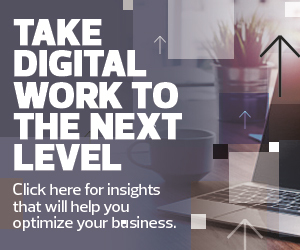At times, the priorities of healthcare organizations, clinicians and patients can seem at odds with one another. But when it comes to the delivery of a modernized user experience, most stakeholders have similar expectations.
As Salesforce points out in a recent blog post, “Customers’ expectations for empathetic, personalized, and digital-first engagement don’t stop when they go to work. Much like consumers, business buyers see a gap between the standards that have been set and the reality they experience.”
From chatbots to new uses for generative AI, healthcare organizations are leveraging automation to meet the demands of both clinicians and patients. The benefits are multifaceted, and they’re paying off for stakeholders with savings of time and money.
Click the banner below to learn how your healthcare organization can leverage automation.
Automated Technology Is Reinventing Patient Support
CDW Digital Experience Manager Anthony Viola says that automation is the biggest driver of change regarding the digital experience. He points out how drastically customer service, and by extension patient support service, has changed over the past 15 to 20 years as a result of automation.
The customer contact center is a department full of opportunities for automation. As CDW notes in a recent blog post, “AI solutions have become an important component of an efficient user experience. Getting a caller to the right person quickly and efficiently minimizes frustration and increases satisfaction. The more that organizations use AI to help customers navigate contact center systems, the better those experiences will be. First-call resolution becomes the norm and not the goal.”
In healthcare, that means patients can be directed to lifesaving care faster or interacted with in a way that makes them more likely to engage with traditional healthcare going forward.
EXPLORE: How AI and automation are supporting clinicians right now.
Automation Can Pay Off Big in Increased Clinical Productivity
Automation can allow a healthcare organization to provide a more efficient experience for both clinical and patient users, and it can benefit organizations as well. A June 2023 report from McKinsey notes the impressive potential of generative AI to increase productivity.
“Our latest research estimates that generative AI could add the equivalent of $2.6 trillion to $4.4 trillion annually across the 63 use cases we analyzed,” notes the report. And those increases will likely be widespread: “About 75 percent of the value that generative AI use cases could deliver falls across four areas: Customer operations, marketing and sales, software engineering, and R&D.”
Productivity isn’t the only benefit healthcare organizations are likely to see from increased adoption of automation, says Matthew Wettstein, solution manager for cloud and digital experience at CDW.
The accessibility of automation can enable clinicians to leverage it in their own roles to increase efficiency and productivity where appropriate. According to Wettstein, a clinician might say, “‘Now I have the tools that I can automate that myself and share it with everyone else.’”
Increased productivity can then lead to the adoption of automated tools for additional purposes, Wettstein says: “Those tools are there, and they’re only getting better. As we’re seeing with programs like Copilot and OpenAI coming in, those things are going to be able to get even more automated” and empower clinicians to drive the improvement of their own digital experiences.












